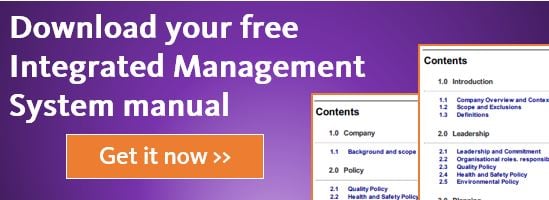When creating Quality Objectives for your Quality Management System (QMS) there is lots to think about and lots to consider.
At a basic level objectives are something that you plan to do or achieve. So if you are going on a road trip, you plan to arrive at your destination by a certain time.
To achieve this you have to take into consideration how long it will take to get there, including all necessary food, toiletry and fuel stops and what resources you have for instance do you have a car or can you take other transportation.
So when it comes to setting quality objectives the same process takes place. You cannot just jot down any random objective off the top of your head. This process requires organised planning and some serious thought.
The thought process needs to include:
- What does our quality policy say?
- What does our organisation want to achieve?
- What do I want my department to achieve?
It is critical for ISO 9001 that the quality objectives are consistent with the quality policy and are relevant to the QMS.
SMART Goals
As I have previously quoted it’s important to use the SMART framework: SMART stands for Smart, Measurable, Attainable, Realistic and Timely.
Specific - this means you need to clearly identify what it is you want to achieve. For example, here at Mango we want to increase our profit by 30% for the next financial year.
Measurable - base line data is necessary to measure your objective against. For example, we will measure our objective by comparing it to the previous year’s profit. We use an excel spreadsheet to measure how we are tracking towards this goal. This helps us understand whether we are ahead, behind, or on track.
Attainable - ask yourself ‘Is this objective achievable?’ and ‘Is it out of reach?’ For us in the Marketing Department in Mango, the objective is to receive 50 qualified leads per month.
Realistic - This is the section where many organisations go wrong. Yes it’s great to dream big but you need to do so realistically. So for Mango 50 qualified leads per month is realistic. But at the same time, the objective needs to be challenging.
Timely - Objectives need to have a timeframe. You can’t just say ‘we will achieve 50 qualified leads’ you need to define the time period that you will achieve this by. Is it over a quarter? Annually? Monthly? This needs to be clearly defined.
You may be asking yourself ‘how do I come up with a relevant objective?’ A good place to start is looking into audit non-conformances and customer complaints. This will help you identify areas for improvement.
How Many Objectives is Enough?
Now you may be wondering, ‘how many objectives should our organisation have?’ Well the answer to this depends on the size of your organisation. It’s important that you don’t put multiple objectives in place for each department otherwise it makes it hard to focus.
Some companies like to have one objective per department. Others like to have 2-3 per department (one short-term goal, one mid-term goal and one long-term goal). If this is the style you choose to go with then it’s important that you celebrate the victory of achieving short-term goals as this will increase motivation in employees when they realise that achieving objectives is possible.
Here at Mango we have 5 departments, these are Sales, Marketing, Support, Development and Accounts. As each department strives to achieve different goals, we decided to create one objective per department. So in total we have 5 objectives. Each objective must be relevant and at the same time enhance customer satisfaction and the quality of the product/service that your company offers.
Communicating Objectives
One area where many companies tend struggle is when they fail to communicate objectives once they’ve been established. If you want to effectively achieve your objectives then communication to all staff is crucial! One great way to do this is to hold a staff meeting.
The following should take place in this meeting:
- Each objective needs to be discussed in detail
- The plan on how each objective will be attained and the time-frame of each objective needs to be clear
- The role of each team member
- Identify who is responsible for meeting the objectives
- Every team member needs to receive a print out of the list of objectives and the steps necessary to reach them
- End with a questions and answers session
At Mango, we held a team meeting and each step above was followed. This was a great success and everyone was aware of how each employee fitted into the success of each objective.
We used Mango to upload our organisations objectives which means any member of our team can log in and view these at any time.
Monitor Objectives
At times, you may find yourself falling behind on your set goals, and this is ok. Sometimes the planning stage may not have been realistic meaning you were set up to fail, or maybe you did not have the necessary resources to meet your objective.
This is why it’s important to constantly monitor your objectives so you can identify when you are not on track and do something about it.
Sometimes you might find yourself smashing your objective/s out of the park. Again, re-evaluate it and adjust it by challenging yourself to get a better result.
Takeaways
- Use the SMART Framework when establishing your quality objectives
- Include team members in the establishment of quality objectives
- If you are struggling to come up with ideas then look at non-conformances and customer complaints
- Try stick to one objective per department
- Communication is KEY! Ensure all team members are aware of the objectives and the steps to meet them
- Monitor the process
- Evaluate the results!
View previous blogs in this series "How to Implement a QMS and Achieve ISO 9001 Certification":
How to Implement a QMS and Achieve ISO 9001 Certification - Part 1: Introduction
How to Implement a QMS and Achieve ISO 9001 Certification - Part 2: Customer Focus
How to Implement a QMS and Achieve ISO 9001 Certification - Part 3: Leadership
How to Implement a QMS and Achieve ISO 9001 Certification - Part 4: Engagement of People
How to Implement a QMS and Achieve ISO 9001 Certification - Part 5: Process Approach
How to Implement a QMS and Achieve ISO 9001 Certification - Part 6: Improvement
How to Implement a QMS and Achieve ISO 9001 Certification - Part 7: Evidence Based Decision Making
How to Implement a QMS and Achieve ISO 9001 Certification - Part 8: Relationship Management
How to Implement a QMS and Achieve ISO 9001 Certification - Part 12: Clause 5.2 Policy
.png?width=200&height=51&name=image%20(2).png)





